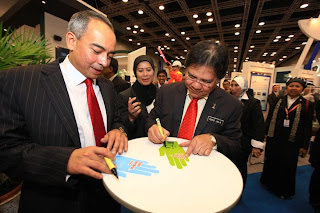LINK :
UNIVERSITI sebagai sebuah menara gading mempunyai tanggungjawab besar untuk memacu perkembangan ilmu demi kebaikan masyarakat dan negara. Bagi memastikan ilmu yang ditimba sentiasa relevan dengan perkembangan semasa, pelbagai usaha perlu digerakkan termasuk melalui penyelidikan sains dan teknologi angkasa.
Himpunan Saintis Muda Malaysia 2011 (MYSA 2011) yang dianjurkan Universiti Sains Islam Malaysia (USIM) baru-baru ini merupakan inisiatif untuk memperkasa budaya penyelidikan saintis dan angkasa di institusi pengajian tinggi awam (IPTA).
MYSA 2011 menjadi medan dalam usaha menyatukan siswazah daripada pelbagai bidang sains IPT yang berazam untuk menjadi saintis terulung pada masa hadapan.
Program MYSA 2011 yang bertemakan 'Saintis Muda Malaysia Ke Arah Pembangunan Mampan' merupakan program kerjasama USIM dengan Kementerian Pengajian Tinggi, Akademi Sains Malaysia (ASM) dan Yayasan Angkasawan Malaysia.
Kini, bidang penyelidikan sains dan teknologi merupakan satu agenda penting dalam pengajian tinggi negara. Ia dilihat sebagai satu anjakan paradigma untuk mempergiatkan lagi usaha melahirkan saintis muda yang berkebolehan dalam prospek profesion saintis dan seterusnya merangka transformasi pembangunan akademik angkasa negara.
Menurut Menteri Pengajian Tinggi, Datuk Seri Mohamed Khaled Nordin, KPT berusaha untuk melaksanakan projek agenda kritikal melalui Pelan Strategik Pengajian Tinggi Negara (PSPTN) yang menjadi asas kepada pembangunan pengajian tinggi menjelang 2020.
Usaha murni ini adalah komitmen KPT dalam menjayakan transformasi pengajian tinggi negara ke arah pembentukan dan penghasilan modal insan yang berkualiti di Malaysia.
PSPTN merupakan satu anjakan ke arah mempertingkatkan pembangunan modal insan demi memperkasakan pengajian tinggi dengan meletakan asas yang kukuh dalam meningkatkan keupayaan pengetahuan dan inovasi negara.
Program MYSA 2011 menjadi tumpuan kepada rata-rata penyelidik saintis muda di IPT dan apa yang menarik, program kali ini buat julung kalinya mempamerkan hasil penyelidikan dalam bidang sains dan teknologi angkasa.
MYSA 2011 mempamerkan program dan kertas kerja penyelidikan angkasa dan kajian yang dilakukan oleh penyelidik dari ASM dalam bidang-bidang seperti angkasa dan saintis.
Salah seorang pelajar Universiti Pertahanan Nasional Malaysia (UPNM), Mohamad Yusrin Yahaya berkata, jika selama ini, bidang sains angkasa dilihat sebagai bidang sampingan berbanding sains dan teknologi, MYSA 2011 dilihat membuka peluang kepada mahasiswa untuk meningkatkan kesedaran mahasiswa dalam mewujudkan jaringan kerjasama bakal saintis muda di negara ini
"Idea-idea himpunan 100 mahasiswa IPT dapat dijelmakan dalam bentuk produk seperti hasil penyelidikan bidang sains dan teknologi angkasa untuk digunakan bagi agensi kerajaan mahupun swasta menambah baik dasar-dasar mahupun polisi yang berkaitan dengan pembangunan angkasa negara.
"Galakan seharusnya diberikan kepada penyelidikan bidang sains angkasa kepada mahasiswa universiti dan sebenarnya boleh digunakan dalam pembentukan dasar kerajaan," katanya.
Himpunan MYSA 2011 mewakili 20 buah IPT untuk menjalin hubungan dengan industri termasuk melalui aktiviti padanan perniagaan. Menerusinya, kedua-dua pihak boleh berinteraksi secara terus seperti ketika sesi pembentangan.
Selain itu, turut diadakan program Amazing Scientist Race dan Cruise Ride Putrajaya
MAHASISWA dan mahasiswi institusi pengajian tinggi seluruh negara bergambar kenangan dalam menjayakan Himpunan Saintis Muda Malaysia 2011 yang diadakan di Hotel Equatorial, Bandar Baru Bangi, Selangor, baru-baru ini.













